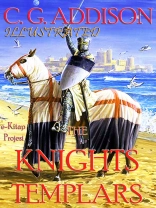• Hugh de Payens returns to Palestine—His death—Robert de Craon made Master—The second Crusade—The Templars assume the Red Cross—Lands, manors, and churches granted them in England—Bernard de Tremelay made Master—He is slain by the Infidels—Bertrand de Blanquefort made Master—He is taken prisoner, and sent in chains to Aleppo—the Pope confers vast privileges upon the Templars;
—The knights, priests, and serving brethren of the order—Their religious and military enthusiasm—Their war banner called Beauseant—Rise of the rival religio-military order of the Hospital of St. John—Contests between Saladin and the Templars—Imprisonment and death of the Grand Master—The new Master and the Patriarch go to England for succour—Consecration of the Temple church at London.
“We heard the tecbir, so the Arabs call
Their shout of onset, when with loud appeal
They challenge heaven, as if commanding conquest.”
Hugh de Payens, having now laid in Europe the foundations of the great monastic and military institution of the Temple, which was destined shortly to spread its ramifications to the remotest quarters of Christendom, returned to Palestine at the head of a valiant band of newly-elected Templars, drawn principally from England and France. On their arrival at Jerusalem they were received with great distinction by the king, the clergy, and the barons of the Latin kingdom. Hugh de Payens died, however, shortly after his return, and was succeeded (A. D. 1136) by the Lord Robert, surnamed the Burgundian, (son-in-law of Anselm, Archbishop of Canterbury, ) who, after the death of his wife, had taken the vows and the habit of the Templars.[6] At this period the fierce religious and military enthusiasm of the Mussulmen had been again aroused by the warlike Zinghis, and his son Noureddin, two of the most famous chieftains of the age.
The one was named Emod-ed-deen, “Pillar of religion;” and the other Nour-ed-deen, “Light of Religion, ” vulgarly, Noureddin. The Templars were worsted by overpowering numbers. The latin kingdom of Jerusalem was shaken to its foundations, and the oriental clergy in trepidation and alarm sent urgent letters to the Pope for assistance.
The Lord Robert, Master of the Temple, had at this period (A. D. 1146) been succeeded by Everard des Barres, Prior of France, who convened a general chapter of the order at Paris, which was attended by Pope Eugenius the Third, Louis the Seventh, king of France, and many prelates, princes, and nobles, from all parts of Christendom. The second crusade was there arranged, and the Templars, with the sanction of the Pope, assumed the blood-red cross, the symbol of martyrdom, as the distinguishing badge of the order, which was appointed to be worn on their habits and mantles on the left side of the breast over the heart, whence they came afterwards to be known by the name of the Red Friars and the Red Cross Knights. At this famous assembly various donations were made to the Templars, to enable them to provide more effectually for the defence of the Holy Land. Bernard Baliol, through love of God and for the good of his soul, granted them his estate of Wedelee, in Hertfordshire, which afterwards formed part of the preceptory of Temple Dynnesley. This grant is expressed to be made at the chapter held at Easter, in Paris, in the presence of the Pope, the king of France, several archbishops, and one hundred and thirty Knights Templars clad in white mantles.
The long Latin and French extracts from the old chronicles have also been discarded from the notes, but the historical references have been preserved to enable the reader, if he thinks fit, to study the quaint and curious language of the originals. By these means, and by enlarging the size of the page, the work has been compressed into a smaller compass, and the price reduced nearly one half.
It is hoped that these alterations will be found to be improvements.












